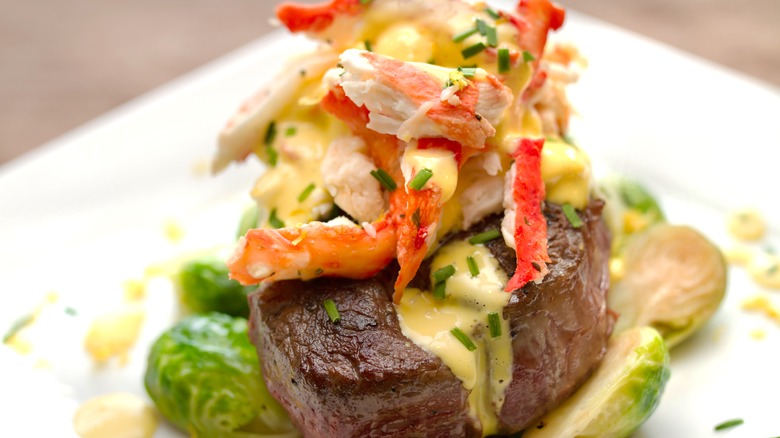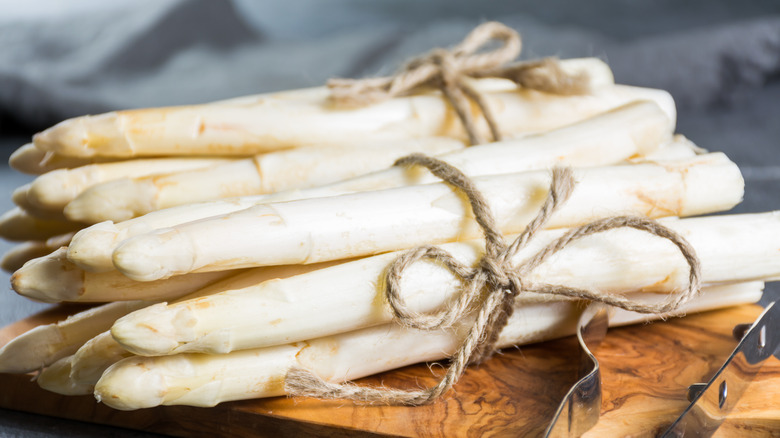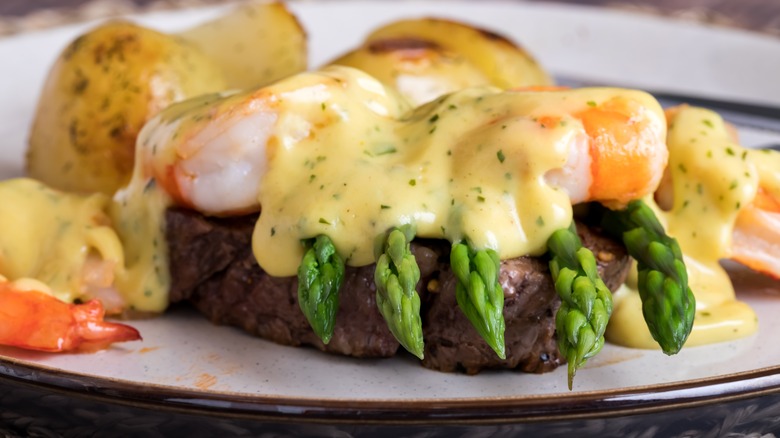What Is Steak Oscar And How Do You Cook It?
When you think of classic luxury dining, steak Oscar is the kind of dish that comes to mind. This upscale surf 'n turf dish was first served in 1897 to King Oscar II of Sweden, and it still bears his name to this day. Originally, the meal consisted of veal seared in butter with white asparagus, crab, and béarnaise sauce. The king had a particular fondness for each of these ingredients. As the 20th century progressed, the veal was replaced by steak, though you can still find veal Oscar in some old-school establishments. Rather than serving the crab and asparagus as sides, they are placed atop the meat.
Making delicious steak Oscar calls for different cooking techniques for each of its ingredients. First, we'll tackle the beef. Filet mignon is the most common cut used today. You can cook this in just about any way you'd like, with some recipes recommending pan roasting and others calling for grilling or broiling. If you want to double down on how decadent the dish is, you can baste the meat with butter while it cooks for a crisp butter-fried steak. However you make it, the dish is traditionally served with meat that is rare or medium-rare. The toppings for this dish can be a little more involved, but are none too difficult.
Tackling the toppings and sauce of steak Oscar
Beef is just one part of the steak Oscar equation; the toppings are equally important. Using canned crab is perfectly fine, but make sure you get high-quality jumbo lump crab meat. You can also get fresh, pre-shucked lump crab from a fishmonger. Either way, pick through the crab for any shells or debris, and then heat it gently with butter until warm. The white asparagus is commonly steamed. You can accomplish this the traditional way, with a steamer insert set over boiling water in a pot, or you can turn to the microwave. Toss the asparagus with a little water and microwave it on high until just tender.
Arguably the most difficult part of making steak Oscar is the creamy béarnaise sauce. With just a bit of practice, however, you can whip up this French classic. Like hollandaise, béarnaise sauce is an emulsion of egg yolk and butter. Although hollandaise features lemon juice, béarnaise instead uses shallots, vinegar, and tarragon.
The difficulty lies in keeping the butter warm enough to stay melted and smooth, without the egg yolks scrambling. One way to avoid this is to use a double boiler, which will keep the temperature low yet consistent while you whisk the butter into the other ingredients. You can also place the yolks and vinegar in a blender and slowly drizzle in warm butter while the blades whip the mixture. As you do this, a stable emulsion should form.
When (and when not) to make substitutions in steak Oscar
Steak Oscar is not always served in its most traditional form. One common change is to sub in shrimp for crab. For this preparation, cook the shrimp in butter, in the same way you would warm up the lump crab. On the other hand, to make the dish even more of a show-stopping luxury, try swapping out the crab for lobster.
While filet mignon is a common choice, it isn't the only kind of steak you can use. Filet is prized for its tenderness, but it tends to lack flavor compared to other steaks, due to its low fat content. For a brawnier piece of beef, try out a New York strip or a T-bone. Avoiding beef in your diet? It's also not unheard of to prepare the dish with chicken. Use chicken cutlets that have been pounded to a uniform, thin size, as they will cook quickly and evenly.
One aspect you might not want to change, however, is the white asparagus. Although its green cousin is often used in modern recipes, white asparagus is actually the most luxurious part of steak Oscar. This special variety is grown without access to sunlight, giving it a pale hue and more delicate, sweeter taste than green asparagus. For the full Oscar experience, stick to the classic here. You can look for it at farmer's markets or even buy it online.



